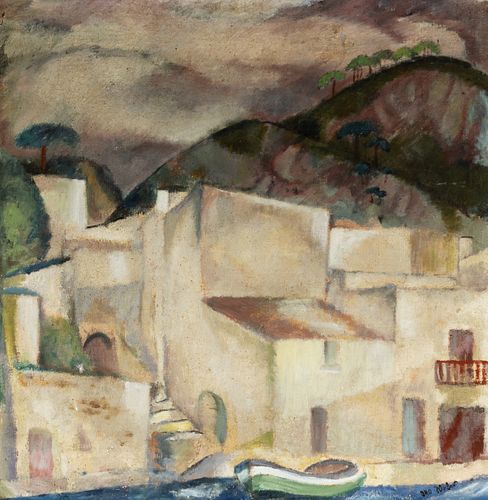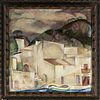OTTO FRIEDRICH WEBER (Germany, 1890-1957). "Village". circa 1915 Oil on canvas.
Lot 9
About Seller
Setdart Auction House
Carrer Aragó 346
Barcelona
Spain
Setdart Subastas was born in 2004 and is currently the first online art auction in Spain with solidity, prestige and reliability guaranteed by our more than 60,000 users. Setdart has a young, dynamic and enterprising team ready to successfully manage the purchase and sale of art works through custom...Read more
Estimate:
EUR€2,500 - EUR€2,700
$2,688.17 - $2,903.23
Absentee vs Live bid
Two ways to bid:
- Leave a max absentee bid and the platform will bid on your behalf up to your maximum bid during the live auction.
- Bid live during the auction and your bids will be submitted real-time to the auctioneer.
Bid Increments
| Price | Bid Increment |
|---|---|
| EUR€0 | EUR€10 |
| EUR€200 | EUR€25 |
| EUR€500 | EUR€50 |
| EUR€1,000 | EUR€100 |
| EUR€3,000 | EUR€200 |
| EUR€5,000 | EUR€500 |
| EUR€10,000 | EUR€1,000 |
| EUR€20,000 | EUR€2,000 |
| EUR€50,000 | EUR€5,000 |
About Auction
By Setdart Auction House
Oct 27, 2021
Set Reminder
2021-10-27 10:00:00
2021-10-27 10:00:00
America/New_York
Bidsquare
Bidsquare : 19th & 20th Century Paintings & Decorative Arts
https://www.bidsquare.com/auctions/setdart-auction-house/19th-20th-century-paintings-decorative-arts-7767
Setdart Auction House sofia@setdart.com
Setdart Auction House sofia@setdart.com
- Lot Description
OTTO FRIEDRICH WEBER (Germany, 1890-1957). "Village". circa 1915 Oil on canvas. Signed in the lower right corner. Measurements: 51 x 51 cm; 60 x 60 cm (frame). Otto Weber initially studied at the Werkkunstschule in Wuppertal, where Max Bernuth was his teacher. His first drawings were acquired by Baron August von der Heydt, father of Eduard von der Heydt, who also allowed the budding artist to attend the painting class at the Dresden Academy. In Munich, Weber became a pupil of Hermann Urban, where he learned the technique of wax color, which was still new at the time. A commissioned work took Weber, who accompanied the landscape painter Edmund Steppes on a trip through southern Germany, to Paris, where he was the only German artist to exhibit at the Salons d'Automne of 1911 and 1913. He lived with numerous Cubist artists at the artists' house La Ruche, in the Passage de Dantzig, and, like his compatriot Arno Breker, was a friend of the young Pablo Picasso. In 1914 Weber traveled to Spain. In Barcelona he joined the colony of artists around Robert Delaunay, who like him had escaped military service and who influenced Weber's work. Weber exhibited at the Josep Dalmau Gallery in 1915, and later in Madrid and Toledo. He made a living drawing caricatures for the Spanish press. In 1919, Weber returned with his family to Elberfeld, where Edmund Becher's Galerie Raumkunst offered him exhibition opportunities. In 1927 he returned to Paris, where the city of Wuppertal commissioned him to design a mural. The newspaper Le Soir called him "the greatest German painter of the time." During the Nazi era, Weber was forbidden to travel, which made it almost impossible for him to work, as he often spent several months of the year in Mediterranean countries for preliminary studies. His paintings, including Die Schreitende, were removed from museums, and his studies were destroyed in the phosphorus attack on Wuppertal in 1943, resulting in the loss of a considerable part of his life's work. Weber lived out the end of the war in Eindhoven. Otto Friedrich Weber was a member of the Rhenish Secession, the Bergische Kunstgenossenschaft and the Malkasten in Düsseldorf. The Von der Heydt Museum in Wuppertal dedicated a memorial exhibition to him in 1958.
- Shipping Info
-
In-house shipping available. Please inquire at admin@setdart.com.
-
- Buyer's Premium



 EUR
EUR CAD
CAD AUD
AUD GBP
GBP MXN
MXN HKD
HKD CNY
CNY MYR
MYR SEK
SEK SGD
SGD CHF
CHF THB
THB














